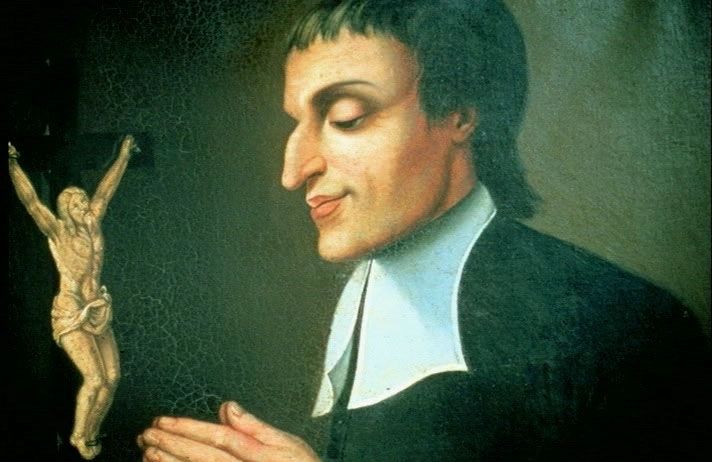 The story of St Peter Chanel is a remarkable one of going the way of the cross. From here:
The story of St Peter Chanel is a remarkable one of going the way of the cross. From here:The protomartyr of the South Seas, St. Peter Chanel was born in 1803 at Clet in the diocese of Belley, France. His intelligence and simple piety brought him to the attention of the local priest, Father Trompier, who saw to his elementary education. Entering the diocesan Seminary, Peter won the affection and the esteem of both students and professors. After his ordination he found himself in a rundown country parish and completely revitalized it in the three year span that he remained there. However, his mind was set on missionary work; so, in 1831, he joined the newly formed Society of Mary (Marists) which concentrated on missionary work at home and abroad. To his dismay, he was appointed to teach at the seminary at Belley and remained there for the next five years, diligently performing his duties.
In 1836, the Society was given the New Hebrides in the Pacific as a field for evangelization, and the jubilant St. Peter was appointed Superior of a little band of missionaries sent to proclaim the Faith to its inhabitants. On reaching their destination after an arduous ten month journey, the band split up and St. Peter went to the Island of Futuna accompanied by a laybrother and an English layman, Thomas Boog. They were at first well received by the pagans and their king Niuliki who had only recently forbidden canabalism. However, the kings jealousy and fear were aroused when the missionaries learned the language and gained the people's confidence; he realized the adoption of the Christian Faith would lead to the abolition of some of the prerogatives he enjoyed as both highpriest and sovereign.
Finally, when his own son expressed a desire to be baptized, the king's hatred erupted and he dispatched a group of his warriors to set upon the saintly head of the missionaries. Thus, on April 28, 1841, three years after his arrival, St. Peter was seized and clubbed to death by those he had come to save. And his death brought his work to completion - within five months the entire island was converted to Christianity.
St. Louis-Marie Grignion de Montfort. From Wikipedia:
French priest and Catholic saint, born in 31 January 1673 at Montfort, ordained to the priesthood in Paris in June 1700, and died at Saint-Laurent-sur-Sèvre on 28 April 1716.

St. Louis was beatified by Pope Leo XIII in 1888 and canonized by Pius XII in 1947. His feast day is celebrated by the Church on 28 April.
The saint served as a missionary among the people of Brittany and the Vendee. His preaching in the Vendee contributed to it being the only region strongly resistant to the anti-clerical revolution of 1792.
St. Louis de Montfort was known for having directed the construction of a calvary among enthusiastic peasants. The King of France, however, under the influence of members of the Jansenist school, was later to order it destroyed. It is reported that upon receiving this disturbing news, he was not perturbed but only declared, "Blessed be God!" St. Louis' spirituality placed great emphasis on the value of obedience. However, he is best known for his promotion of Marian devotion.
Grignion de Montfort's approach of "total consecration to Jesus Christ through Mary" had a strong impact on Marian devotion both in popular piety and in the spirituality of religious orders.
The thought, writings, and example of St. Louis de Montfort, an example of the French school of spirituality, have been singled out in an encyclical by the late Pope John Paul II as a distinctive witness of Marian spirituality in the Catholic tradition; the pontiff also spoke of his reading the saint's work The True Devotion to Mary as a "turning point" in his life.
His popular book The Secret of the Rosary is approved by the Catholic church and is an easily readable, multi-perspective approach to the Holy Rosary that has been read by Catholics worldwide for over two centuries. "True Devotion to Mary" has been called the greatest Marian book of all time.
No comments:
Post a Comment